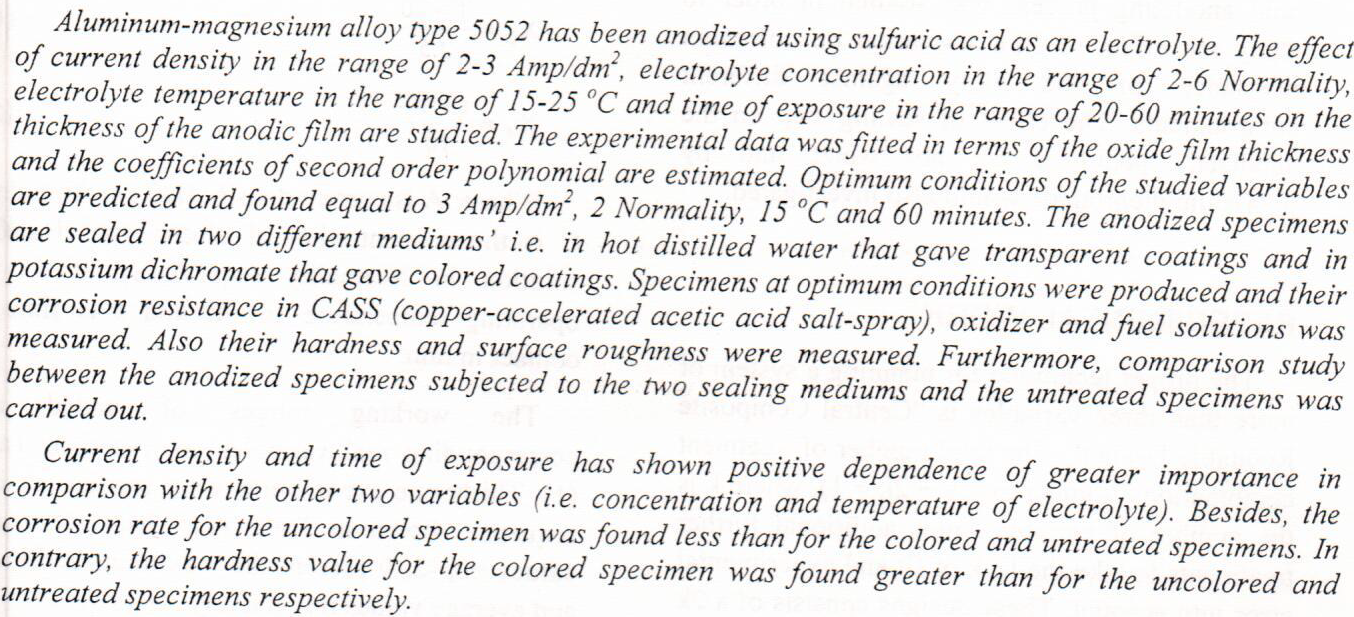
The nanocompsite of alumina (Al2O3) produced a number of beneficial effects in alloys. There is increasing in resistance of materials to surface related failures , such as the mechanical properties , fatigue and stress corrosion cracking .The experimental results observed that the adding of reinforced nanomaterials type Al2O3 enhanced the HB hardness, UTS, 0.2 YS and ductility of 2014 Al/Al2O3 nano composites . the analysis of experiments, indicated that The maximum enhancement was observed at 0.4 wt.% Al2O3. The ultimate improvement percentage were 15.78% HB hardness, 18.1% (UTS), 12.86% (
... Show More (7)
(7)
Heat treatment by solid solution method in the ?+? phase region was used at 970°C for Ti-5Al-2.5Fe alloy. The specimens cooled under different cooling media [water quenched (WQ), air cooled (AC) and furnace cooled (FC)], and subsequently aged at 550°C for 4 hours. Five specimens from each treatment were immersed in simulated body fluid SBF for a period of time (3 months). The dependence of corrosion rate on compositional variation in the phases resulted from various type of cooling rates are discussed based on immersion tests. The EDXA results show the precipitation of phosphate and calcium compounds on the alloy after 3 months of immersion in blood plasma solution forming a bone-like apatite, which enhanced the alloy biocompatibility ma
... Show MoreTetragonal compound CuAl0.4Ti0.6Se2 semiconductor has been prepared by
melting the elementary elements of high purity in evacuated quartz tube under low
pressure 10-2 mbar and temperature 1100 oC about 24 hr. Single crystal has been
growth from this compound using slowly cooled average between (1-2) C/hr , also
thin films have been prepared using thermal evaporation technique and vacuum 10-6
mbar at room temperature .The structural properties have been studied for the powder
of compound of CuAl0.4Ti0.6Se2u using X-ray diffraction (XRD) . The structure of the
compound showed chalcopyrite structure with unite cell of right tetragonal and
dimensions of a=11.1776 Ao ,c=5.5888 Ao .The structure of thin films showed
This research concern to analyse and simulate the temperature distribution in the spot welding joints using tungsten arc welding shielded with inert gas (TIG Spot) for the aluminum-magnesium alloy type (5052-O).
The effect of and the quantity of the heat input that enter the weld zone has been investigated welding current, welding time and arc length on temperature distribution. The finite element method (by utilizing programme ANSYS 5.4) is presented the temperature distribution in a circular weld pool and the weld pool penetration (depth of welding) through the top sheet ,across the interface into the lower sheet forming a weld spot. &nbs
... Show MoreThis paper develops a nonlinear transient three-dimensional heat transfer finite element model and a rate independent three-dimensional deformation model, developed for the CO2 laser welding simulations in Al-6061-T6 alloy. Simulations are performed using an indirect coupled thermal-structural method for the process of welding. Temperature-dependent thermal properties of Al-6061-T6, effect of latent heat of fusion, and the convective and radiative boundary conditions are included in the model. The heat input to the model is assumed to be a Gaussian heat source. The finite element code ANSYS12, along with a few FORTRAN subroutines, are employed to obtain the numerical results. The benefit of the proposed methodology is that it
... Show MoreMicrobial fuel cell is a device that uses the microorganism metabolism for the production of electricity under specific operating conditions. Double chamber microbial fuel cell was tested for the use of two cheap electrode materials copper and aluminum for the production of electricity under different operating conditions. The investigated conditions were concentration of microorganism (yeast) (0.5- 2 g/l), solutions temperature (33-45 oC) and concentration of glucose as a substrate (1.5- 6 g/l). The results demonstrated that copper electrode exhibit good performance while the performance of aluminum is poor. The electricity is generated with and without the addition of substrate. Addition of glucose substrate
... Show More (2)
(2)
In this work, the effect of aluminum (Al) dust particles on the DC discharge plasma properties in argon was investigated. A magnetron is placed behind the cathode at different pressures and with varying amounts of Al. The plasma temperature (Te) and density (ne) were calculated using the Boltzmann equation and Stark broadening phenomena, which are considered the most important plasma variables through which the other plasma parameters were calculated. The measurements showed that the emission intensity decreases with increasing pressure from 0.06 to 0.4 Torr, and it slightly decreases with the addition of the NPs. The calculations showed that the ne increased and Te decreased with pressure. Both Te and ne were reduced by increasing
... Show MoreThis study aimed to evaluate the surface changes of commercial pure Titanium disks (CP Ti) and the Ti 13Nb 13 Zr (Alloy) with a zigzag pattern of laser surface treatment. In vitro, experimental study of CNC Laser treatment on the CP Ti and Alloy disks. Texturing the surfaces of CP Ti and Alloy disks via CNC laser, the sample disks were analyzed using surface roughness, wettability and FESEM. The FESEM revealed a proper increase in the surface texturing and roughness on macro and micro measures without crack formation or dramatic change of the core substance of the CP Ti and Alloy disks. The CNC laser is an effective and suitable method for surface texturing CP Ti and Alloy for dental implantology. Keywords: Commercial pure Titanium;
... Show More (1)
(1)
 (3)
(3)
 (1)
(1)
